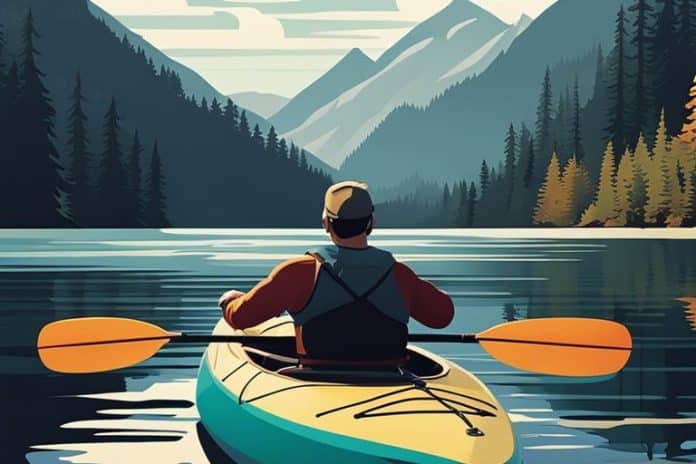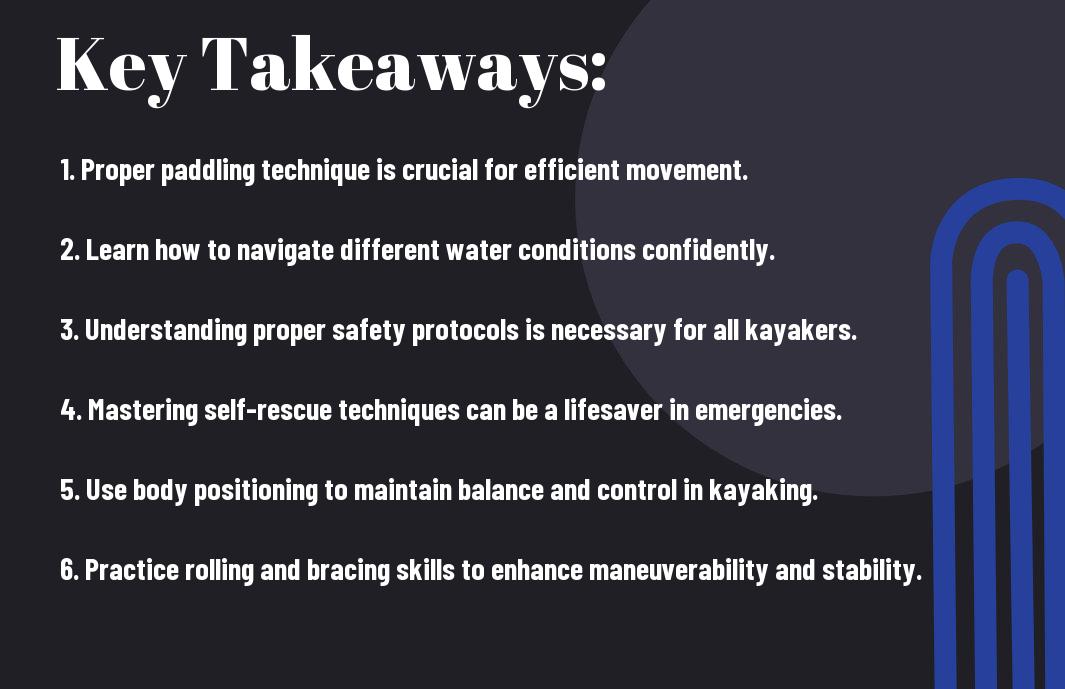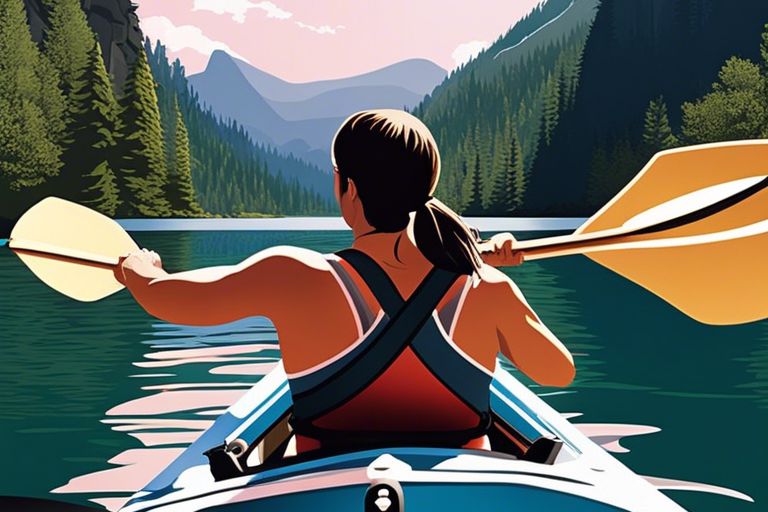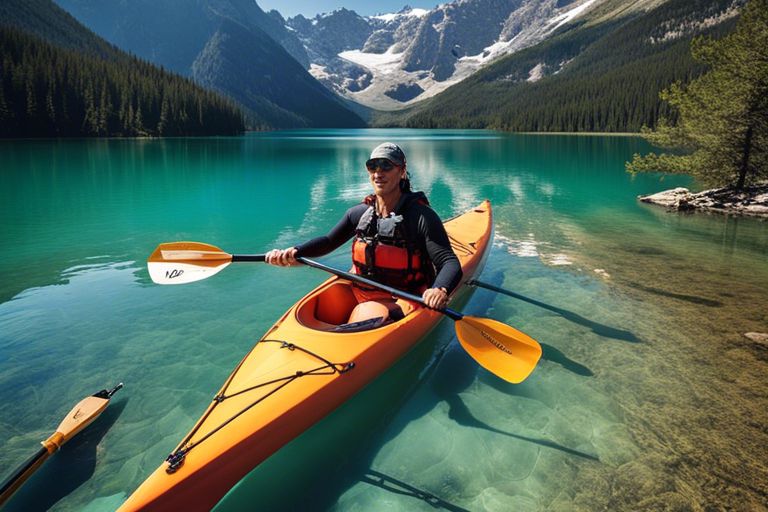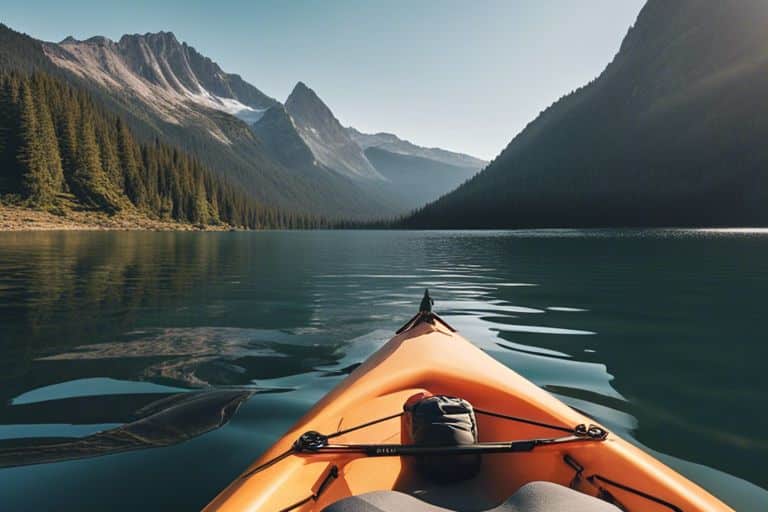With the thrill of adventure awaiting on the open waters, mastering necessary kayaking skills is paramount for every outdoor enthusiast. Whether navigating calm lakes or challenging whitewater rapids, having a strong foundation in key techniques can make all the difference in ensuring a safe and enjoyable experience. In this guide, we will explore the most crucial skills every kayaker should hone, from proper paddling techniques to necessary safety tips. By familiarizing oneself with these fundamental skills, adventurers can confidently initiate on kayaking excursions, knowing they are well-prepared for whatever the waters may bring.
Key Takeaways:
- Balance: Maintaining balance is crucial to staying upright in a kayak, practice this skill on calm waters before tackling rougher conditions.
- Paddle Strokes: Master basic paddle strokes like forward, reverse, sweep, and draw to effectively navigate different water conditions.
- Bracing: Learn how to brace with your paddle to prevent capsizing in rough waters or when encountering unexpected obstacles.
- Rolling: Practice the technique of rolling your kayak upright after capsizing, a skill that can be a game-changer in challenging situations.
- Navigation: Develop navigation skills using a map, compass, and understanding of currents and tides to plan safe and enjoyable kayaking trips.
- Self-Rescue: Know how to perform self-rescue techniques such as T-rescue or paddle float rescue to re-enter your kayak after capsizing.
- Safety Awareness: Prioritize safety by wearing a personal flotation device (PFD), dressing appropriately for the conditions, and being aware of weather forecasts and water conditions.
Basic Paddling Techniques
The Forward Stroke
Assuming you’re new to kayaking, mastering the forward stroke is important for propelling your kayak through the water efficiently. For the best results, ensure your body rotation is engaged, and your paddle blade is fully submerged before pulling it back. This technique will help you maintain a straight course and increase your speed on the water.
The Reverse Stroke
Stroke by stroke, the reverse stroke is a pivotal technique for kayakers. It allows you to move backward smoothly and with control. To execute this stroke, simply rotate your torso in the opposite direction of where you want to go, plant the blade near your hips, and push the water away from you. This maneuver is handy when you need to slow down, stop, or navigate tight spaces.
Turning Strokes
Reverse sweeps and forward sweeps are two turning strokes every kayaker should master. Reverse sweeps involve a wide stroke from the back to the front of the kayak and help you turn quickly, especially in tight spots. In contrast, forward sweeps are ideal for making gradual turns by starting at the front of the kayak and ending at the back.
These turning strokes are important for maneuvering your kayak through different water conditions and obstacles. Practicing these techniques will enhance your overall control and agility on the water, allowing you to navigate smoothly and confidently.
Safety Procedures and Rescue Techniques
Many adventure seekers are drawn to the thrilling sport of kayaking for its unique blend of excitement and natural beauty. However, before you commence on your next paddling trip, it is imperative to familiarize yourself with the Kayak Essentials that can make all the difference in an emergency situation.
Capsize Recovery
Recovery: Capsize recovery is a crucial skill that every kayaker should master. In the event of a capsize, remaining calm is key. The most common technique is the wet exit, where you exit the kayak and then proceed to flip it back upright. Practicing this maneuver in a controlled environment will help you react effectively in turbulent waters.
Assisted and Self-Rescue
Assisted: Understanding assisted and self-rescue techniques can be a lifesaver in challenging situations. Assisted rescue involves helping another kayaker back into their boat or towing them to safety. Self-rescue techniques, such as the paddle float self-rescue or the cowboy scramble, empower you to regain control and continue your journey without outside assistance.
Navigating the Waters
Reading River and Ocean Conditions
Not all waters are created equal when it comes to kayaking. It is crucial for adventurers to understand how to read river and ocean conditions before setting out. Factors such as currents, tides, winds, and water depth can significantly impact your kayaking experience. Learning to identify these conditions can help you navigate safely and effectively.
Understanding Weather Patterns
An vital skill for kayakers is understanding how weather patterns can influence your time on the water. Reading weather forecasts, identifying changing conditions, and knowing how to react to different weather scenarios are vital for a successful kayaking trip. Being aware of incoming storms, strong winds, or sudden changes in temperature can make all the difference in your safety and enjoyment.
Reading weather patterns can also help you plan your kayaking trips more effectively. Knowing when to expect calm waters or favorable winds can enhance your overall experience, while being aware of potential thunderstorms or rough conditions can prevent dangerous situations. By understanding weather patterns, you can make informed decisions to ensure a smooth and enjoyable kayaking adventure.
Advanced Kayaking Skills
- Eskimo Roll
- Efficient Paddling for Long-Distance Trips
Eskimo Roll
One of the most advanced and imperative skills to master in kayaking is the Eskimo Roll. This technique allows you to right yourself and your kayak if you capsize in rough waters. It involves a series of coordinated movements where the kayaker stays upside down in the water, uses their paddle to perform a rolling motion, and brings themselves back up without exiting the kayak. It requires practice, proper body positioning, and precise paddle strokes to execute successfully.
Efficient Paddling for Long-Distance Trips
Trips that involve long distances require efficient paddling techniques to conserve energy and maintain speed. Efficient paddling involves proper torso rotation, using the larger muscles in your body to power the strokes, and maintaining a steady rhythm to cover longer distances with less effort. Plus, mastering efficient paddling techniques not only improves your endurance but also reduces the risk of muscle strain and fatigue during extended kayaking journeys.
Kayak Care and Maintenance
Routine Kayak Care
Keep your kayak in top condition by following a regular maintenance routine. After each use, rinse your kayak with fresh water to remove any salt or debris that could cause damage. Store it in a cool, dry place away from direct sunlight to prevent fading and warping. Regularly check the hardware and fittings for any signs of wear and tear, and replace them as needed.
Dealing with Repairs
One crucial aspect of kayak maintenance is knowing how to handle repairs. From minor scratches to major cracks, knowing how to fix issues can save you time and money in the long run. Invest in a kayak repair kit that includes tools for patching holes, sealing cracks, and repairing dents. If you’re unsure about a repair, seek professional help to ensure the safety and integrity of your kayak.
The most important aspect of dealing with repairs is to address any issues promptly to prevent further damage. Ignoring small problems can lead to more significant issues down the line, potentially compromising the safety of your kayak and your own well-being. Stay informed about common repair techniques and practice them regularly to keep your kayak in optimal condition.
Summing up
From above, mastering crucial kayaking skills is crucial for any adventurer looking to navigate waterways safely and efficiently. By learning proper paddling techniques, practicing self-rescue methods, understanding water dynamics, and enhancing navigation skills, a kayaker can confidently explore diverse environments and enjoy thrilling adventures on the water. Be mindful of, safety should always be a top priority in any water-based activity. So, equip yourself with these fundamental skills and launch on your kayaking expeditions with confidence and preparedness.
FAQ
Q: What are crucial kayaking skills every adventurer should master?
A: Essential kayaking skills that every adventurer should master include paddling techniques, rescue and safety skills, and navigation skills.
Q: Why is it important to master kayaking skills?
A: Mastering kayaking skills is crucial for ensuring a safe and enjoyable experience on the water. These skills can help you navigate difficult terrain, respond effectively to emergencies, and improve your overall performance as a kayaker.
Q: How can I improve my kayaking skills?
A: You can improve your kayaking skills by taking lessons from qualified instructors, practicing regularly on different types of water bodies, and participating in guided kayak tours. Additionally, staying up to date on safety protocols and investing in quality gear can also enhance your kayaking skills.
